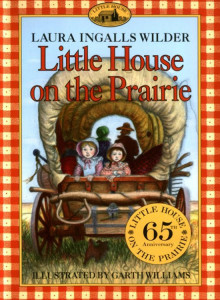I never read these books as a child, being too busy with fairy tales and Arthurian stories, and never saw the television series. However, Caroline Fraser’s biography of Wilder, Prairie Fires, came highly recommended to me, so I thought I’d better catch up on these children’s books.
In this, the third book in the loosely autobiographical series, Laura and her family leave their beloved Wisconsin house in the big woods, described in the first book, and set out for Kansas. The experience of traveling in a covered wagon is vividly conveyed, seen from young Laura’s perspective, though the discomforts are minimised. Laura, her older sister Mary, and baby Carrie get restless sitting in the wagon all day, and Laura worries about the dog Jack who has to run the whole way, but she’s also fascinated by all she sees and comforted by the sound of the horses feeding as she goes to sleep.
As in the other books, the small family encounters hazards and setback, but Ma and Pa can always be relied upon to keep the girls safe and feeeling loved. Eventually they find themselves on an open, seemingly uninhabited prairie near Independence, Kansas. The descriptions of the grasslands—their shy colors and scents, their creatures and breezes—show a genuine love of this land.
Reading this book as an adult gives me a curious double perspective. I know too well the ecological damage done by farmers like Pa plowing up the fragile prairie. I know too much about blatant lies of the government and railroads that lured homesteaders onto lands not appropriate for wheat farming, and of course about the injustice and genocide visited upon the Osages who in fact inhabited this land.
There has been some outcry about the depiction of the Osages in these books, but at least in this one I found it pretty even-handed. Remember that it is from a child’s point of view, one who knows nothing of the larger picture or the history. When the Native Americans do turn up on their seasonal migration, Ma and some of the other nearby homesteaders are afraid of them, but Pa treats them as neighbors, with courtesy and respect. Young Laura describes the ones she actually meets as beautiful and awe-inspiring.
I also know too much about poverty, and do not take at face value the nostalgic recreation of life in a one-room cabin with sometimes only potatoes for dinner. If I’d read this book as a young child, in a bedroom well-stocked with toys and books, nourished on three balanced meals a day, I wonder how I would have reacted to young Laura’s blissful descriptions of her single doll, a rag doll made by Ma, and the comfort of a single potato or turnip for dinner and Pa’s fiddle afterwards.
As an adult, I was fascinated with her detailed description of the house Pa built: the way he notched the logs, put on the roof, built the door, and crafted leather hinges for it. Laura’s childish pursuits are charming, but what captured me was Ma and Pa’s endless toil, the heartbreak of lost harvests, the impossibility of breaking even.
It was not a simpler time; it was an infinitely more difficult time. I’ve chopped wood for winter fuel and washed clothes with a washboard. I’ve tried to live off what I can raise. The hardships of frontier life, of homesteading don’t seem romantic to me. Perhaps they might have if I’d read these books as a child, unaware of all that was being glossed over.
Have you read or reread a children’s book that seems different to you as an adult?


Awesome article.
735977bb3f70db1f72682b952d15966a